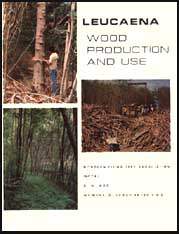Leucaena is a tropical tree with many uses. This manual deals with leucaena grown primarily for wood production. In a companion publication the production of leucaena forage for animal feed and other uses is considered. Leucaena is also the subject of a publication of the U.S. National Academy of Science (1984) and the annual LEUCAENA RESEARCH REPORTS published by the Nitrogen Fixing Tree Association. Other references on Leucaena may be found in the section on additional reading.
Leucaena is known botanically as Leucaena leucocephala (Lam.) de Wit. The name "leucaena" is the accepted international name for this one species, but it is also the name of the genus that includes at least 9 other species. Some of the common names for leucaena are:
|
|
|
|
|
|
|
|
Leucaena is a tree that has been used widely for wood, fuel, forage, and other purposes. It has been said to be a "miracle tree" because of its fast growth and wide adaptability. Experience has shown that there are no miracle trees, that every species has limitations in site requirements and utilization. Leucaena is limited to the lowland tropics and sub-tropics by temperature and light requirements, and to non-acid (pH > 5.0) soils.
Leucaena is a member of the sub-family Mimosoideae of the family Leguminosae, a family of some 18,000 species. Legumes are noted for their ability to fix atmospheric nitrogen in forms available as nutrients to the growing plant. Most of this fixed nitrogen is found in the leaves as protein. The nitrogenrich leaves of leucaena can be used to improve soil fertility, to nourish other plants as a source of green manure, and as an animal feed.
Nitrogen fixation occurs on the roots, in small nodules that are infected with bacteria. In the case of leucaena, the nodule-forming bacteria are of the genus Rhizobium. Some soils lack this bacterium, and it must be provided together with the seed if nitrogen fixation is to take place.
1-2 ORIGIN AND DISTRIBUTION
Leucaena originated in Central America and Mexico, where it is still widespread today, primarily in dry lowland regions. The precise location of its origin is not known, but its earliest center of diversity is presumed to be the Yucatan in Mexico. Most leucaenas found in natural stands are very similar to the aggressive, freely-seeding, shrubby type of the west coast of Mexico. This shrubby type is often referred to as "Hawaiian type" due to its domination of lowland forests in Hawaii.
Leucaena was transferred to Asia from West Mexico in the 16th and 17th centuries at the time of the galleon trade. It moved further in the 19th century, becoming popular as a feed or forage plant, and later as a shade tree (nurse tree) for coffee, cacao, and other plantation crops. Today leucaena may be found in almost all tropical countries, especially on coral-derived soils of islands, where it often dominates the vegetation. This is particularly true on Pacific islands such as Corregidor, Saipan and Oahu where seed of the Hawaiian type were aerially sown. More recently, the species has generated wide interest as a fuelwood, and as a source of wood for charcoal, pulp, and other industrial uses.
1-3 APPEARANCE
Leucaena has become best known to the forester through tall, arboreal types known as "giant" or "Salvador-type". The giants are native not only to Salvador but have been found as a genetic variant throughout the region of origin. The trees grow rapidly on good sites to 15m in 4-5 years, and mature trees reach heights of approximately 20m. The common leucaena, however, is a shorter tree or shrub, often overpopulating and producing a canopy of 5lOm i5-10m in height. This common type has been used for fuelwood, but is low in yield and is best replaced with the giant cultivars. Individual trees growing without competition form a relatively branchy crown. However, when planted at high stocking densities branching is suppressed and lateral branches self-pruning (Figure 12).
Leucaena leaves are divided bipinnately into short branches (pinnae) 8 to 15mm in length with 11-22 pairs of leaflets per pinna. In extreme drought, the leaves fall off. None of the leucaenas are thorny. Leucaena produces dense, globular white flowers which when fertilized bear brown, flat pods that hang in clusters. Pods and seeds of the giant types are much larger than those of the Hawaiian type.
1-4 USES
Leucaena produces a medium hardwood that is widely used as a firewood, producing little ash and smoke. The wood produces a satisfactory pulp, which can be used for paper and rayon. The wood can be used for parquet flooring and small furniture, but trees generally do not become large enough for major use as lumber. Poles can be harvested from leucaena for use as posts and props.
The leucaena tree or shrub in nature often acts as a soil enriching plant, and helps in erosion control. The trees have been interplanted as sources of nutrients ("nurse trees") for plantation crops like cacao, coffee, pepper and forest species such as teak. They can also be used as windbreaks or firebreaks when planted at high population densities. They grow back rapidly after harvesting, or following low-intensity fire or light frost.
An expanding use of leucaena is to provide leaves for green manure to fertilize staple food crops. Leucaena can be cut or trimmed regularly as a shrub to provide nutrients to intercropped corn, cassava, and other nitrogen-demanding row crops. It is also a protein-rich leaf meal for use in animal rations.
Among the many other uses of leucaena are seed mats and lets, craftwood, food products for human use (young leaves, young seeds), and small poles to prop beans, bananas, and climbing plants.
